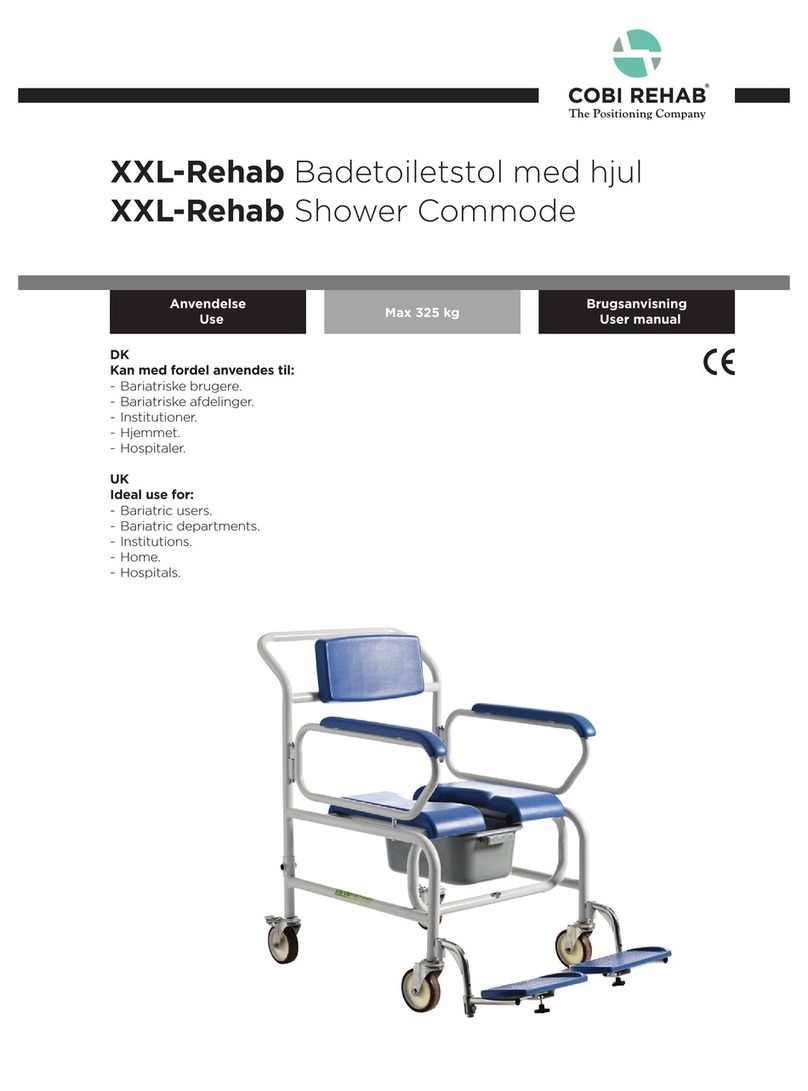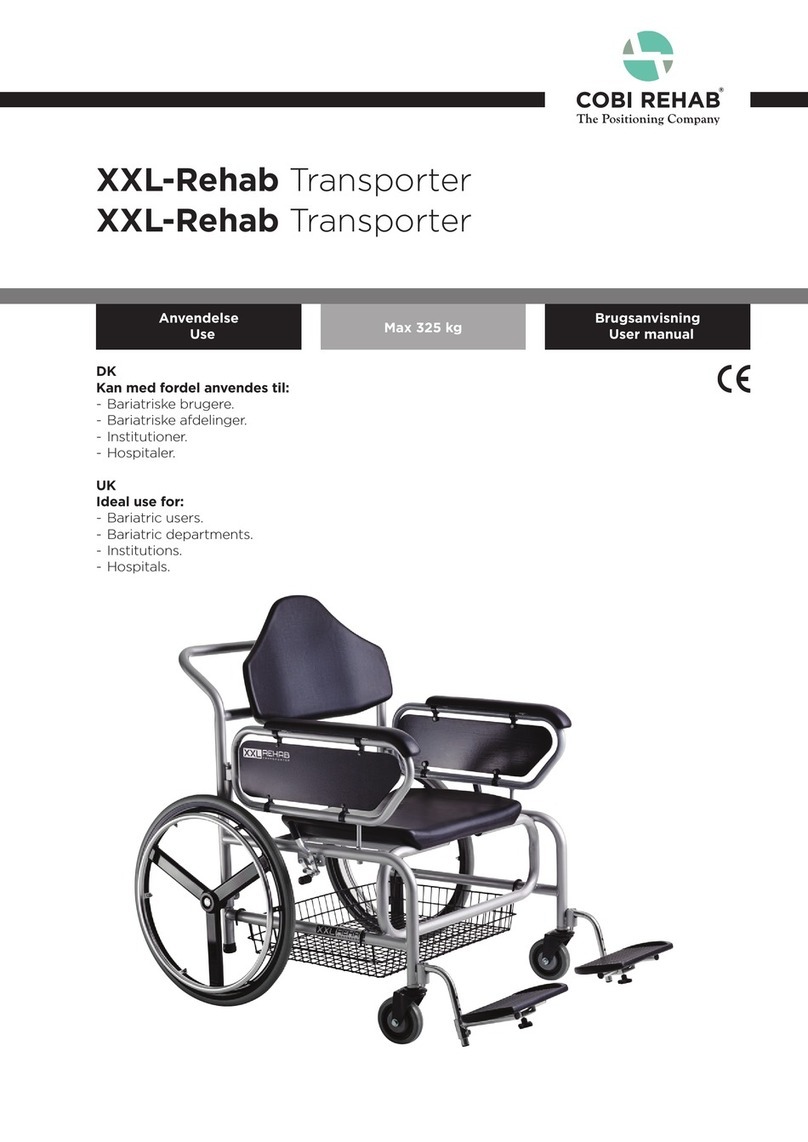Cobi Rehab Cruise Power User manual

Cobi Cruise bariatric comfort wheelchair
Cobi Cruise comfort wheelchair. The most powerful wheelchair on the
market for use in the rehabilitation of bariatric users.
Cobi Cruise comfort wheelchair is used in care centres and hospitals, in home care and
in private homes for bariatric users in need of a comfort wheelchair with a pressure-
relieving seat.
Cobi Rehab and Cobi Rehab suppliers comply with the UN conventions
on child labour and forced labour as well as ILO 029, C132 and C182.
USER MANUAL
UP TO 325 KG
•Used in all phases of rehabilitation, from the
bedridden user to the mobile user.
•Cobi Cruise is equipped with tilt-in-space
and recline functions which are activated
via a controller and operated by both user
and care staff.
•Armrests that can be angled and pushed
away for e.g., transfers or social activities
at a table.
•Disinfectable and washable in laundry
room at e.g., a depot or a hospital.

| 04-2022 User Manual Cobi Cruise
2
Contents
1. Safety .................................................................................................................................................................................................3
2. Indications.......................................................................................................................................................................................4
3. General comments ......................................................................................................................................................................5
4. Application .....................................................................................................................................................................................5
5. Construction ..................................................................................................................................................................................6
6. Electric tilt-in-space and recline ...........................................................................................................................................9
7. Before use .....................................................................................................................................................................................10
8. Possible adjustments ................................................................................................................................................................ 11
9. Maintenance and cleaning ..................................................................................................................................................... 12
10. Transport and storage........................................................................................................................................................... 12
11. Recycling and disposal ........................................................................................................................................................... 13
12. Warranty ...................................................................................................................................................................................... 13
13. Specifications............................................................................................................................................................................. 14
14. Accessories and spare parts ............................................................................................................................................... 15

| 04-2022 User Manual Cobi Cruise
3
WARNING
Do not use Cobi Cruise comfort wheelchair without thorough instruction
from trained staff or from persons who have received instruction in the
use of the wheelchair. Improper operation may injure the user.
Using Cobi Cruise comfort wheelchair for people weighing more than
the maximum user weight of 325 kg increases the risk of damaging the
wheelchair.
Read this user manual carefully before using the Cobi Cruise comfort
wheelchair. Pay particular attention to Safety Instructions marked .
Cobi Rehab assumes no responsibility for any damage to the product
nor for personal injury caused by incorrect installation, incorrect
mounting, or incorrect use of the Cobi Cruise wheelchair.
Immediately contact Cobi Rehab if parts are damaged or missing. Never
use your own spare parts.
Cobi Rehab cannot be held responsible for errors or accidents occurring
after repairs are made without the written permission of Cobi Rehab.
SAFETY INSTRUCTIONS
In this user manual, the symbol indicates a safety instruction. Follow
safety instructions carefully.
The care staff assesses whether the user should be restrained in the
Cobi Cruise comfort wheelchair during use for safety reasons.
Always lift users not able to stand and walk in and out of the Cobi
Cruise comfort wheelchair.
Always take care when using the tilt-in-space and recline function to
avoid jerky movements.
The maximum user weight of the Cobi Cruise comfort wheelchair is 325
kg.
The stopping distance on slopes can be significantly longer than on
even ground.
The surface temperature can rise when the wheelchair is exposed to
external heat sources e.g., sunlight.
Due to their large width, certain Cobi Cruise models may have difficulty
passing through ordinary doorways and emergency exits.
Always use helper control for users with impaired cognitive function.
Always ensure that the wheelchair is charged.
1. Safety

| 04-2022 User Manual Cobi Cruise
4
Caution!
Double insulated (class II)
Declaration of conformity, Medical Device
Regulation, EU 2017/745
IPX6
Water resistant class
Max. 10° slope of ground
Dispose of through correct waste management
Cobi Catalogue number
Serial number
Year of manufacture
Manufacturer
Medical device
Max. user weight
Consult the manual
CE-Label located at the frame.
See an example of an CE-label below.
2. Indications
Always monitor and guide users with reduced
cognitive function in the user of the electrical
functions of the wheelchair.
2.1 Counter-indications

| 04-2022 User Manual Cobi Cruise
5
4. Application
This user guide contains important information
about the use of Cobi Cruise and the target group
for the wheelchair. It also includes a wide range of
specifications on the Cobi Cruise.
The most recent version of this user guide can be
found on our website. Check if the version you are
reading now is the most recent.
If you need a user guide that is written in a larger
font size, the product sheet is available in PDF
format at cobirehab.com, which can be scaled up
to the required font size.
You can always contact Cobi Rehab on telephone
+45 7025 2522 or e-mail
cobi@cobi.dk
if you want
more information about Cobi Cruise comfort
wheelchair.
Cobi Rehab reserves the right to change the
product specifications without providing prior
notice.
The UDI number of the wheelchair appears on the
label, which is located on the side of the frame.
Product safety notices and product recalls can be
viewed on the website.
3. General comments
The Cobi Cruise comfort wheelchair is designed
for indoor use, e.g., in hospitals, institutions and in
care homes. The wheelchair can also be used in
private homes.
The wheelchair is intended for bariatric users up
to 325 kg whose ability to stand and walk is
limited.
The intended operator of the wheelchair is a
health professional, such as a therapist, nurse, or a
social and health worker. The intended operator
could also be the bariatric user with trunk stability
and the ability to drive, control and break the
wheelchair
.
The wheelchair can be used in ambient
temperatures of 0°-40°C and a humidity of
20-80%.
The wheelchair can also be used outdoors but is
primarily for indoor use.

| 04-2022 User Manual Cobi Cruise
6
5. Construction
Cobi Cruise is constructed from S355 high-tensile
steel. The rectangular steel profiles of the chair
form the basis for its base frame. The base frame
is made up of two mirror-inverted parts (a right
and a left part) connected by a centre module.
This structure allows the sides to be reused if the
width needs changing.
The seat frame of the wheelchair consists of
30x30x2 mm high-tensile steel profiles. In
addition, the seat frame has a 2 mm steel seat
plate attached to it, which helps to distribute the
pressure in the best possible way.
The back of the wheelchair consists of a high-
tensile steel profile. The profile is positioned
centrally on the back of the wheelchair. The angle
of the profile means that the back supports both
apple-shaped and the pear-shaped users. Three
back plates are mounted on the profile. The back
plates are curved to hug and support the user
from buttocks to neck.
Curved back plates support and hug the user from
buttocks to neck.
Pear-shaped users with voluminous backsides are
ensured good back support, as the design of the
"spine" of the wheelchair and its lower back plate
provide space for the backside.
The upper two back plates ensure that apple-
shaped users enjoy stable and comfortable back
support.
The back cushion is divided into nine modules,
which are sewn together into one large cushion.
All nine modules consist of two parts. A firm foam
layer and layer with a mixture of polystyrene
beads and latex foam.
The foam layer faces the back of the wheelchair
while the bead and foam layer are the one sat on
by the user. The bead and foam mixture are
modular and helps to increase the comfort of the
wheelchair and its pressure relieving effect.
Each of the nine back
cushion modules of the
back cushion consists
of a firm foam layer
and a layer of beads
and latex foam.
The back cushion is
made up of nine
modules sewn into one
large cushion.
The contents of in each cushion module can be
adjusted. This means that, according to
professional assessment, the therapist or care
staff can add or remove beads and latex foam. If
necessary, a wedge cushion can also be inserted
in one or more modules. The cushion contents are
adjusted via the nine zippers located on the back
of the cushion.
The modular cushion follows the shape of the
back plates and, thus, ensures correct support
regardless of user’s body shape and needs.
The modular cushion can be finely adjusted using
a patented FitGo system known from ski boots
and work shoes. The FitGo system is located on
the back plates.
The FitGo system comprises an adjusting knob. The
button is activated when pressed. If the button is to
be loosened, pull it upwards and the cord pull is
then released.
The
FitGo system should only be adjusted by care
staff as improper pressure distribution may harm
the user.

| 04-2022 User Manual Cobi Cruise
7
The base of the seat cushion consists of hard foam.
The core of the seat cushion consists of memory
foam specially selected for the target group.
The top consists of soft foam. The seat cushion is
upholstered with a flame retardant incontinence
cover.
5.1 The seat cushion
Extra-long armrests (615 mm) ensure stability and a
good grip when the user moves from a standing to
a sitting position or vice versa.
The armrests can swivel back, making it easier to
move the user from e.g., the chair to the bed. The
arm rests can also be pushed down making it
possible to move the wheelchair close to the edge
of a table, allowing the user to participate in social
activities there.
The armrests are padded for extra comfort and
"cup-shaped" thus reducing the risk of pressure
ulcers. Each armrest can withstand a maximum
load of up to 200 kg.
Caution: The user may fall out of the wheelchair if the
arm rest is pushed back
.
5.2 Armrests
The seat cushion is made up of three different types of foam.
Extra-long and strong arm rests.
Swivelling arm rests allow positioning near a table.
The leg rests each support up to 200 kg and are
adjustable in both height and position. They also
have a swivel function that allows easier access to
and from the wheelchair.
The angle of the foot plates, the height/angle of
the leg rest and the angle of the calf plates can be
adjusted without tools.
The position of the foot and calf plates is adjusted
using a 10 mm closed spanner and a Torx 25. The
closed spanner and the Torx is not included in the
purchase of leg rests.
The flexibility of the leg rests means that the
user's legs can always be supported. This benefit,
inter alia, users with a significant tissue on their
inner thighs.
The leg rests may be removed without the use of
tools without affecting stability.
Do not use the leg rests when getting in and out.
5.4 Leg rests
Leg rests each supporting up to 200 kg.
The leg rests can be dismantled without using tools.
The handlebar is flexible and adjustable, using a
click system. Major adjustments can be made with
tools. The bar has several grip points, depending
on whether the chair is to be pushed or
manoeuvred.
Ensure that the handlebar is in place.
5.3 Push bar

| 04-2022 User Manual Cobi Cruise
8
The wheelchair neck support is an option. The
wheelchair is supplied with a universal neck support
bracket, allowing for the installation of different types
of neck support.
5.5 Neck support
Cobi Cruise is equipped with two 24” drive
wheels. The drive wheels can be placed in five
different positions (with tools).
The two front positions are intended the active
user, who thereby gets easier access to the
wheels. The three rear positions are intended the
passive user who is not expected to drive the
wheelchair.
5.6 Wheels
A universal neck support bracket permits the
installation of several types of neck supports.
The two parking brakes are located on each side
of the frame and can be operated by both user
and caregivers.
The disc brakes are operated by means of a brake
lever mounted on the push bar. The brake lever
can only be operated by the caregiver.
5.9 Brakes
The Cobi Cruise has three actuators. Two seat
actuators and a back actuator. The two seat
actuators control the tilt-in-space function. The
seat actuators are installed under the seat.
The back actuator controls the recline function.
The back actuator is also installed under the seat.
5.8 Actuators
Two actuators (marked blue) control the tilt-in-space
function. One actuator (red) controls the recline
function.
The control box is installed on the base plate.
Dismantling the control box requires tools but
should only be undertaken by Cobi Rehab service
engineers.
The electronics are IPX6-classified. This means
that the wheelchair and its components can
withstand high pressure and heavy sprays of
water
.
The electronics of the wheelchair does not disturb
the operation of units in the surrounding
environment which emit electromagnetic fields,
e.g., alarm systems in shops, automated doors,
etc.
5.10 Control box
Cobi Cruise is installed with anti-tip that can be
adjusted to suit the terrain. Only remove the Anti-
tip when transporting the wheelchair without a
user.
Risk of tipping when anti-tip is removed.
5.7 Anti-tip
Cobi Cruise is equipped with both hand brakes and
disc brakes.

| 04-2022 User Manual Cobi Cruise
9
6. Electric tilt-in-space and recline
Negative tilt helps the independent user in safely
getting in and out of the wheelchair. Negative tilt
means that the front of the seat cushion is
lowered. This reduces the access height which, in
turn, makes getting in and out easier for the
independent user. The function negative tilt is
activated using the controller.
Recline provides the apple-shaped user with
supported and comfortable seating. When the
back of the wheelchair is tilted backwards, the
pelvis of the user is automatically opened. This
provides improved respiration for apple-shaped
users. The recline function is controlled using the
same controller as for the electric tilt-in-space
function.
Erroneous use of the tilt-in-space and recline
functions can lead to the user experiencing respiratory
difficulties, including users with impaired cognition.
Using the negative tilt function may cause the user
to slide forward.
The battery indicator is shown at the top of the
remote control. Be sure to charge the wheelchair
when the battery flashes in the red box.
The illustrations indicate which functions are
activated by pressing the arrows. The arrows on
the top illustration activate the recline function.
The wheelchair can recline from 90°-120°.
The arrows in the lower illustration activate the
tilt-in-space function from -4°-13°.
In the event of an irregularity, the RESET function
must be activated. Press and hold down the two
arrows, marked with a red dot, for 5 seconds,
after which the various functions can be accessed
again.
After a RESET procedure, it is important to check
that all three actuators are still functional. The
wheelchair can be damaged if, for example, one of
the seat actuators has a loose connection. Such a
loose connection can twist the wheelchair.
Misuse of the RESET button can damage the user
and wheelchair.
6.1 Controller
The controller has:
•
A battery indicator
•
Tilt-in-space function
•
Recline function
•
RESET function

| 04-2022 User Manual Cobi Cruise
10
When the user is placed in the wheelchair for the
first time, the need for extra filling in the various
back modules must be professionally assessed.
If extra filling is needed, move the user out of the
wheelchair, after which professionally trained staff
adds or removes filling from the cushions in
question.
If additional support is needed, a wedge system
can be used. This assessment is made by
professionally trained staff during the actual
adjustment.
7. Before use
If the user can independently move from bed to
wheelchair:
•
Swivel the footrests to the sides
•
Adjust the seat angle to the needs of the user
•
The user sits in the wheelchair
•
Swing the footrests back into position if
required for the activity.
When moving a passive user from bed to
wheelchair using a sling:
•
Swivel the footrests to the sides if required by
the user
•
Adjust the seat angle to the needs of the user
•Adjust the hip angle of the backrest depending
on the needs of the user
•
Tilt the wheelchair backwards
•Slide back one arm rest. Lift user sideways into
the chair
•
Swivel back the footrests
•
Slide back the arm rest.
7.1 From bed to wheelchair

| 04-2022 User Manual Cobi Cruise
11
Risk of crushing or getting caught
Be careful not to get the user’s tissue or fingers caught when adjusting the arm rests. This also applies when using
the swivelling function of the leg rests.
8. Possible adjustments
When the user is placed in the wheelchair for the
first time, the need for extra filling in the various
back modules must be professionally assessed. If
extra filling is needed, move the user out of the
wheelchair, after which professionally trained staff
adds or removes filling from the cushions in
question.
In addition, the tilt-in-space and recline function
enables changes in position and optimises the
conditions in connection with moving in and out
of the chair.
The seat depth can be adjusted in several ways,
e.g., by using the FitGo system or by adjusting
elements in the back cushion. In addition, the seat
depth can also be adjusted.
However, the latter adjustment requires a
technician. Cobi Rehab recommend completing
this before starting the specific adjustment.
Risk of fingers getting caught between the seat and
the frame when tilting.
Risk of tissue getting caught between arm rest and
back when reclining.
8.1 Adjusting the back module
Adjust leg rests to lower legs of the user. Adjust
the angle of the foot plates in relation to the
user's positioning of the feet. Adjust the calf
support to provide the user with both support
and relief of the calves.
The angle of the arm rests can be height-adjusted
and adjusted in a perpendicular position or in a
downward-facing position, allowing the user to
move close to a table. The arm rests can also be
pulled back in connection with the application
and/or removal of slings.
The above adjustments are made by pulling out
the button on the bracket at the front of the arm
rest.
The neck support bracket of the Cobi Cruise is
universal. This allows for the installation of the
most suitable neck support.
8.2 Other possible adjustments
Always measure the user when the user is seated.
If help is needed in terms of measuring the user,
please contact Cobi Rehab on telephone
8.3 Measuring the user

| 04-2022 User Manual Cobi Cruise
12
When transporting Cobi Cruise, we strongly recommend adjusting the seat to 0° position as a minimum. If
possible, we recommend adjusting the seat to -4° position. We also recommend adjusting the back to 97° or less.
The Cobi Cruise is easy to clean. If the seat needs
disinfecting, remove, and disinfect it using ethanol
70-85% or a chlorine product of min. 1000 ppm
and max. 10000 ppm.
Clean the frame, seat and arm rests of the
wheelchair using water and a regular cleaning
agent.
Cobi Cruise comfort wheelchair can be
disinfected or washed in a laundry room at e.g., a
depot or a hospital.
The controller can be disinfected using ethanol
70-85% or a chlorine product of min. 1000 ppm
and max. 10000 ppm.
When the wheelchair is not in use, store in a dry
place at a temperature between -10°- 50°C.
The Cobi Cruise is suitable for land and/or air
transport (when not accommodating a user). The
Cobi Cruise cannot be folded as it has a fixed
frame. To avoid injuries to e.g., the back, we
advise against carrying the 100 kg wheelchair.
The wheelchair can be lifted by the frame if it is to
be transported (without a user) in a motorised
vehicle.
Cobi Cruise is not crash tested and can therefore
not be used as a passenger seat in motorized
vehicle.
10. Transport and storage
When storing the Cobi Cruise for longer periods
of time (3+ months), store the wheelchair at
0°-30° degrees and in a humidity not exceeding
75%.
We recommend charging the battery to 40–60%
prior to storage.
When putting the wheelchair into use again after
long-term storage, connect it to the supply and
charge it for a
t least two hours. Keep an eye on
the battery capacity as the wheelchair will
discharge over time.
10.1 Long-term storage
9. Maintenance and cleaning

| 04-2022 User Manual Cobi Cruise
13
Dispose of products that are no longer in use in
an environmentally safe manner. Contact your
local authority for further information on disposal.
Contact Cobi Rehab for further information on the
recycling of lithium batteries and wheelchair
parts.
Cobi Rehab warrants that the Cobi Cruise comfort
wheelchair is without defects on delivery. If,
against all expectations, the wheelchair is subject
to deficiencies or defects on receipt, please
contact Cobi Rehab immediately.
The warranty period for the Cobi Cruise comfort
wheelchair is one year from the date of purchase
and covers manufacturing defects or defect on
receipt. The invoice is your certificate of warranty.
The warranty does not apply to:
- products on which the serial number, batch
number or the like have been removed or
significantly damaged.
- products which have been repaired by
unauthorised personnel.
The warranty does not cover:
- wearing parts.
This warranty does not apply when Cobi Rehab
assesses that the Cobi Cruise comfort wheelchair
has been improperly operated.
For damage caused by improper operation, an
invoice will be issued for both the service and the
spare parts used.
12. Warranty
11. Recycling and disposal
Report any incidents relating to the use of Cobi
Cruise to Cobi Rehab.
12.1 Accidents
After the expected service life, it is important that
an overall assessment of the product is made
before continued use.
After the expected service life, Cobi Rehab
cannot guarantee the suitability and safety of the
product, as Cobi Rehab has no control over how
the product is used and wear and tear.
The overall assessment of the product must be
carried out by qualified professionals, and as a
minimum, consideration must be given to how the
product has been used, the condition of the
product and its components.
Cobi Rehab can always make such an assessment.
12.2 After expiry of expected service life

| 04-2022 User Manual Cobi Cruise
14
Max. user weight
325 kg
Risk class
I
Basic UDI DI
5740000100023N6
Expected product service life
Minimum 7 years
Crash-tested
No
Seat depth
480-600 mm, at 30 mm intervals
Back angle
90°- 120°, continuously variable
Seat angle
-4 - 13°
Height from front of seat to ground
(Height stated without cushion. Add 100 mm if cushion included)
337-551 mm
Height of back rest
613 mm
Max. length excl. footrests / incl. footrests
approx. 1246 mm - 1773 mm
Min. length excl. footrests / incl. footrests
approx. 987 - 1054 mm
Seat width
550-1000 mm, at 50 mm intervals. 100 mm between 700 and 1000 mm
Max. total width
676-926 mm
Max. total height
1115 mm
Max. weight of wheelchair
100 kg
Max. downhill inclination
10°
Max. uphill inclination
10°
Max. sideways inclination
10°
Massive tyres
Massive tyres with PU core
Frame tubing (material)
S355 high-tensile steel
Seat cushion filling
CMHR 50250 (base), Visco 45060 (core), CMHR 4038 (top), flame-retardant
Back cushion filling
CM 2740 (base), Cut latex and EPS-beads (the front), flame-retardant
Back and seat cushion
Covered in incontinence cover (G469 black), flame-retardant
Arm rest cushion
Foam (CMHR4250 and RF5060), cover durable imitation leather (Temskay
Leather), flame-retardant
Cushion in foot and lower leg support
Foam (CMHR4038), cover durable imitation leather
(Temskay Leather), flame-retardant
Push bar
S355 high-tensile steel
Wheel forks
Aluminium
Footrest tubing
Steel
Foot plate
S355 High-tensile steel
Turning radius (Pivot)
100-120 cm
13. Specifications

| 04-2022 User Manual Cobi Cruise
15
Foldable
No
Battery
Li-Ion 24V 2,6 Ah
Three actuators
LINAK LA23
Control box
LINAK
Controller
LINAK HB30
Wheelchair, including components
DS/EN 12183: 2014, in accordance with ISO 7176
IP-code
IPX6
Risk assessment
EN/ISO 14971: 2012
General requirements and test methods
EN 12182:2012
Accessory
Part number
Elevation leg rest R
0115-999-006
Elevation leg rest L
0115-999-007
Cobi Cruise IV-holder with installation bracket(s)
0115-999-090
Neck support
Contact us for the choice of neck support
For spare parts, please contact Cobi Rehab on telephone +45 7025 2522 or at
14. Accessories and spare parts

| 04-2022 User Manual Cobi Cruise
16
MANUFACTURER
Cobi Rehab
Fuglebækvej 1D
DK-2770 Kastrup
Denmark
+45 7025 2522
cobirehab.com
Other manuals for Cruise Power
1
This manual suits for next models
1
Table of contents
Other Cobi Rehab Wheelchair manuals

Cobi Rehab
Cobi Rehab Eclipse User manual
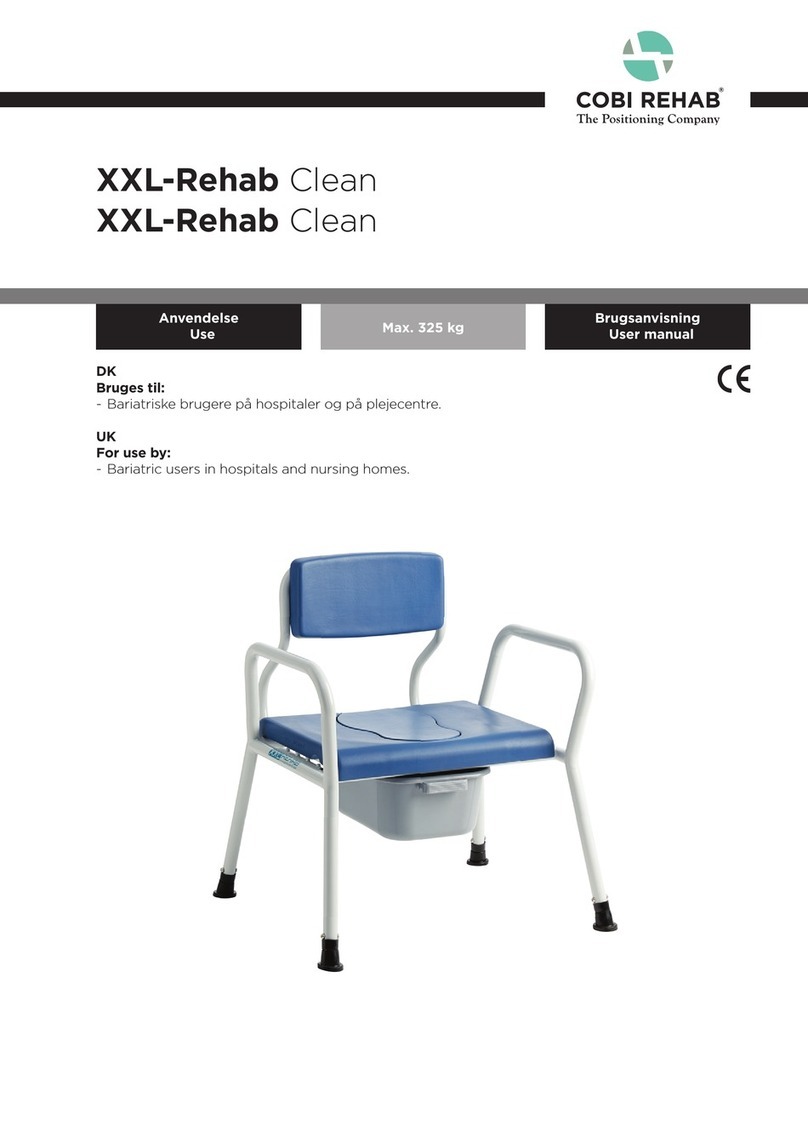
Cobi Rehab
Cobi Rehab XXL-Rehab Clean User manual
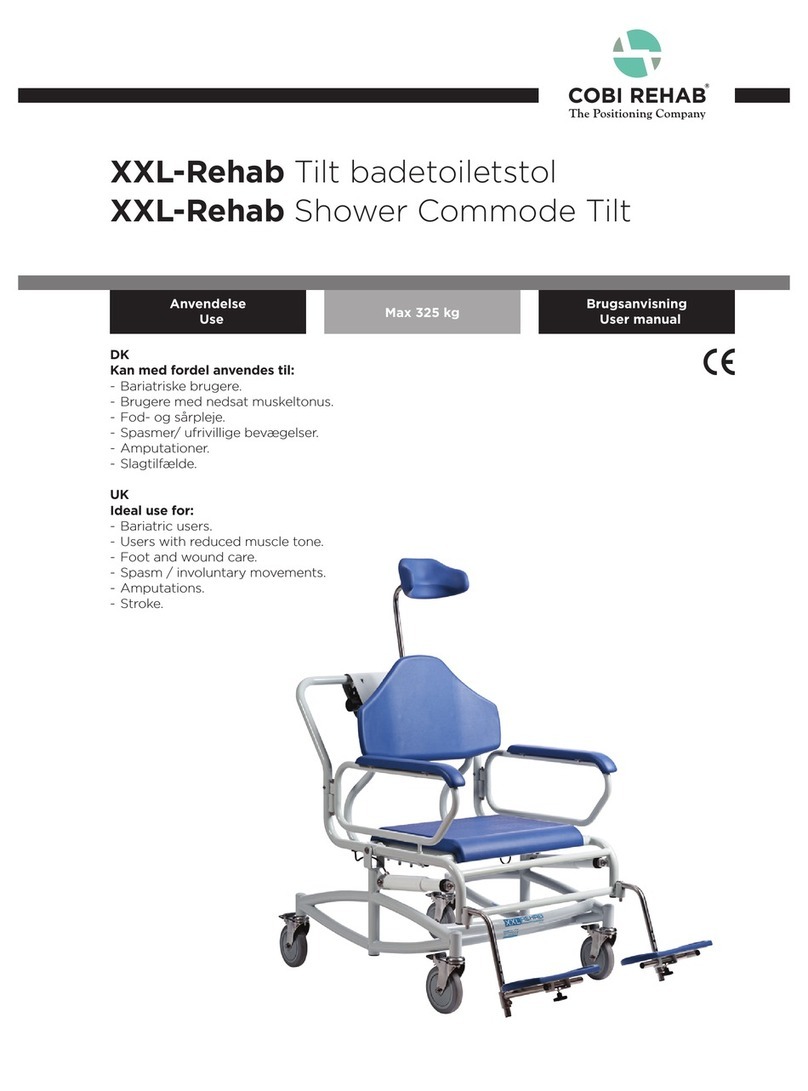
Cobi Rehab
Cobi Rehab XXL-Rehab Shower Commode Tilt User manual

Cobi Rehab
Cobi Rehab XXL-Rehab User manual

Cobi Rehab
Cobi Rehab Eclips Tilt User manual

Cobi Rehab
Cobi Rehab XXL-Rehab Shower Bench User manual

Cobi Rehab
Cobi Rehab Kamille Comfort Guide
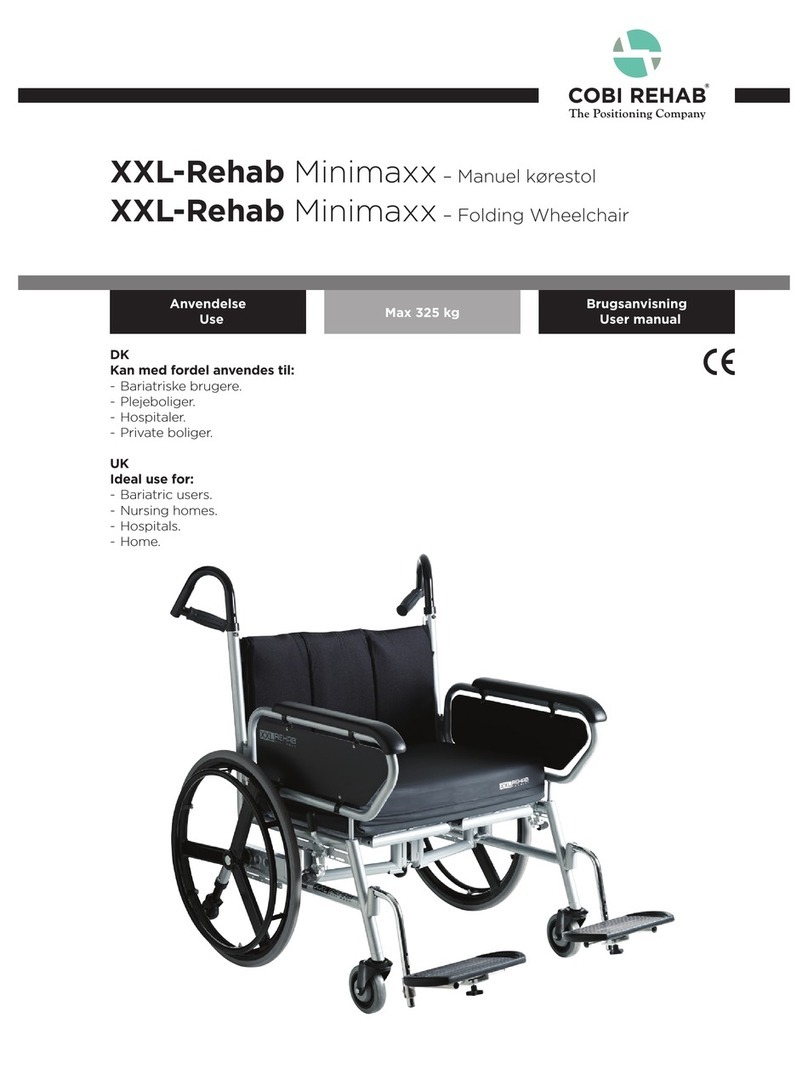
Cobi Rehab
Cobi Rehab XXL-Rehab Minimaxx User manual
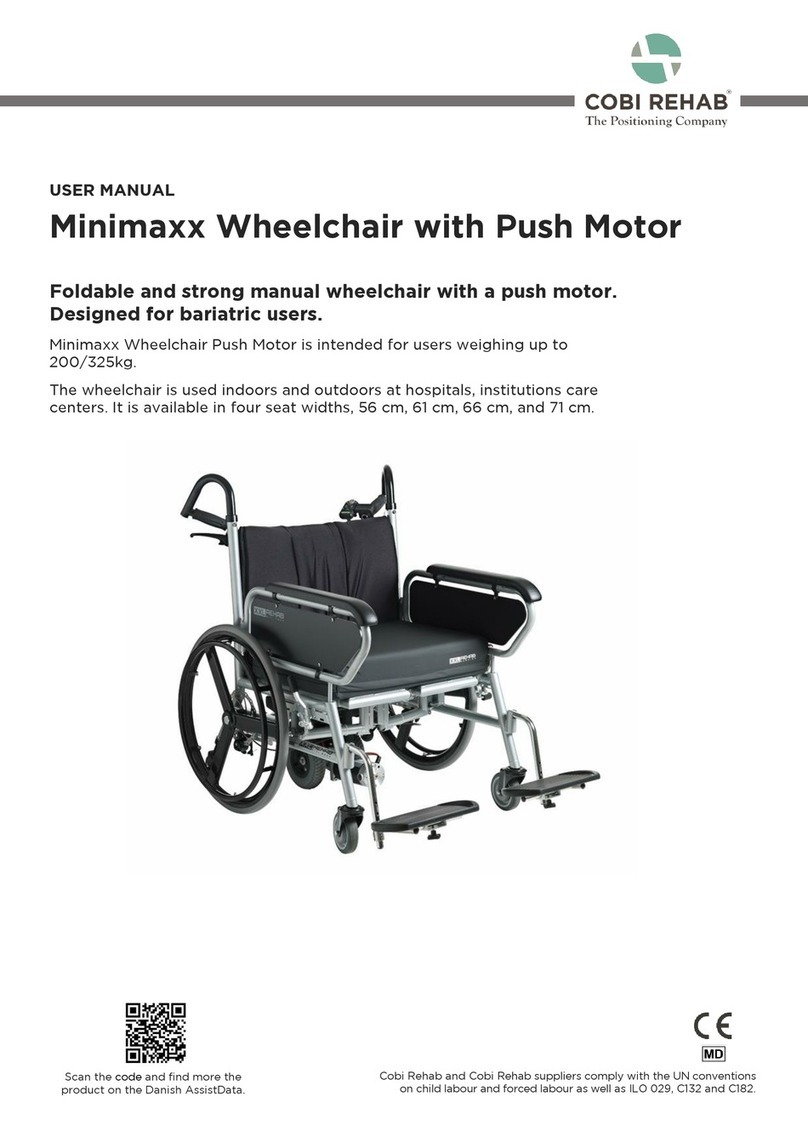
Cobi Rehab
Cobi Rehab Minimaxx Push Motor User manual

Cobi Rehab
Cobi Rehab Minimaxx User manual

